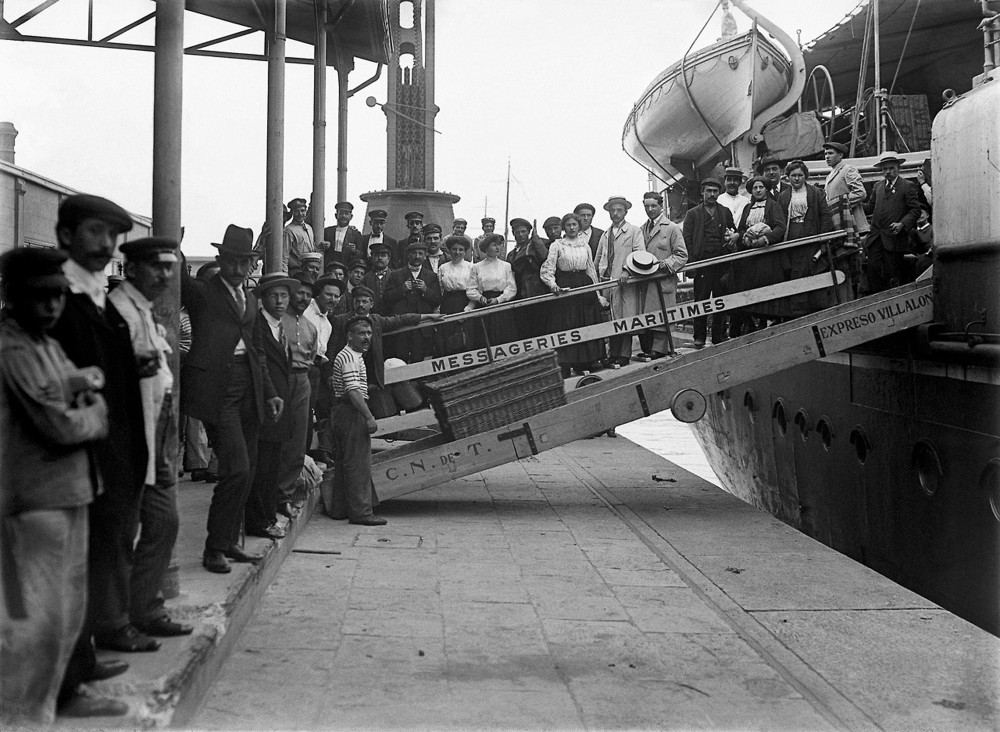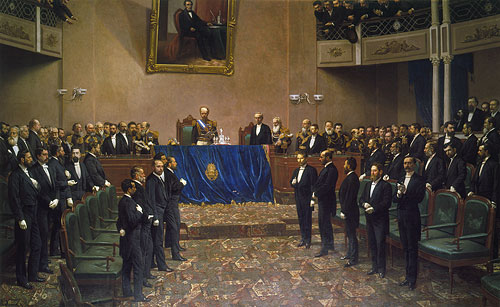|
Great European Immigration Wave To Argentina
The great European immigration wave to Argentina took place in the late 19th and early 20th century. It consisted mostly of Italian and Spanish immigrants, along with other nationalities such as French, Slavs (especially Ukrainians, Poles, Russians and Croatians), Germans (many of whom were registered with other nationalities upon arrival in the country, for example as Russians, since most of them were ethnic Germans from different parts of Europe)Swedish, Danish and Welsh, among others, including Jews. During this period Argentina saw a huge increase in population. Some groups of European immigrants modified the politics of Argentina by introducing political movements from their source countries, such as labor unionism, anarchism and socialism. Causes Before the immigration, Argentina was sparsely populated. The Spanish colonization of the Americas favored Mexico and Peru, the southern Spanish regions had no sources of wealth and had lower populations. This population ... [...More Info...] [...Related Items...] OR: [Wikipedia] [Google] [Baidu] |
Labor Unionism
A trade union (labor union in American English), often simply referred to as a union, is an organization of workers intent on "maintaining or improving the conditions of their employment", ch. I such as attaining better wages and benefits (such as holiday, health care, and retirement), improving working conditions, improving safety standards, establishing complaint procedures, developing rules governing status of employees (rules governing promotions, just-cause conditions for termination) and protecting the integrity of their trade through the increased bargaining power wielded by solidarity among workers. Trade unions typically fund their head office and legal team functions through regularly imposed fees called ''union dues''. The delegate staff of the trade union representation in the workforce are usually made up of workplace volunteers who are often appointed by members in democratic elections. The trade union, through an elected leadership and bargaining committee, ... [...More Info...] [...Related Items...] OR: [Wikipedia] [Google] [Baidu] |
Generation Of '80
The Generation of '80 ( es, Generación del '80) was the governing elite in Argentina from 1880 to 1916. Members of the oligarchy of the provinces and the country's capital, they first joined the League of Governors (''Liga de Gobernadores''), and then the National Autonomist Party, a fusion formed from the two dominating parties of the prior period, the Autonomist Party of Adolfo Alsina and the National Party of Nicolás Avellaneda. These two parties, along with Bartolomé Mitre's Nationalist Party, were the three branches into which the Unitarian Party had divided. In 1880, General Julio Argentino Roca, leader of the Conquest of the Desert and framer of the Generation and its model of government, launched his candidacy for president. They filled the highest public political, economical, military and religious positions, staying in power through electoral fraud. In spite of the growing political opposition, led by the Radical Civic Union (UCR) and anarchist and socialist groups ... [...More Info...] [...Related Items...] OR: [Wikipedia] [Google] [Baidu] |
Third Carlist War
The Third Carlist War ( es, Tercera Guerra Carlista) (1872–1876) was the last Carlist War in Spain. It is sometimes referred to as the "Second Carlist War", as the earlier "Second" War (1847–1849) was smaller in scale and relatively trivial in political consequence. Leading up to the war, Queen Isabella II abdicated the throne in 1868, and the unpopular Amadeo I, son of the King of Italy, was proclaimed King of Spain in 1870. In response, the Carlist pretender, Carlos VII, tried to earn the support of various Spanish regions by promising to reintroduce various area-specific customs and laws. The Carlists proclaimed the restoration of Catalan, Valencian and Aragonese fueros (charters) which had been abolished at the beginning of the 18th century by King Philip V in his unilateral Nueva Planta decrees. The call for rebellion made by the Carlists was echoed in Catalonia and especially in the Basque region (Gipuzkoa, Álava, Biscay and Navarre), where the Carlists managed to de ... [...More Info...] [...Related Items...] OR: [Wikipedia] [Google] [Baidu] |
Otto Von Bismarck
Otto, Prince of Bismarck, Count of Bismarck-Schönhausen, Duke of Lauenburg (, ; 1 April 1815 – 30 July 1898), born Otto Eduard Leopold von Bismarck, was a conservative German statesman and diplomat. From his origins in the upper class of Junker landowners, Bismarck rose rapidly in Prussian politics, and from 1862 to 1890 he was the Minister President of Prussia, minister president and List of foreign ministers of Prussia, foreign minister of Prussia. Before his rise to the Executive (government), executive, he was the Prussian ambassador to Russian Empire, Russia and Second French Empire, France and served in both houses of the Landtag of Prussia, Prussian Parliament. He masterminded the unification of Germany in 1871 and served as the first Chancellor of Germany#Under the Emperor (1871–1918), Chancellor of the German Empire until 1890, in which capacity he dominated European affairs. He had served as the chancellor of the North German Confederation from 1867 to 1871, alon ... [...More Info...] [...Related Items...] OR: [Wikipedia] [Google] [Baidu] |
International Workingmen's Association
The International Workingmen's Association (IWA), often called the First International (1864–1876), was an international organisation which aimed at uniting a variety of different left-wing socialist, communist and anarchist groups and trade unions that were based on the working class and class struggle. It was founded in 1864 in a workmen's meeting held in St. Martin's Hall, London. Its first congress was held in 1866 in Geneva. In Europe, a period of harsh reaction followed the widespread Revolutions of 1848. The next major phase of revolutionary activity began almost twenty years later with the founding of the IWA in 1864. At its peak, the IWA reported having 8 million members while police reported 5 million. In 1872, it split in two over conflicts between statist and anarchist factions and dissolved in 1876. The Second International was founded in 1889. Origins Following the January Uprising in Poland in 1863, French and British workers started to discuss developing ... [...More Info...] [...Related Items...] OR: [Wikipedia] [Google] [Baidu] |
Constitution Of Argentina Of 1853
The Argentine Constitution of 1853 is the current constitution of Argentina. It was approved in 1853 by all of the provincial governments except Buenos Aires Province, which remained separate from the Argentine Confederation until 1859. After several modifications to the original constitution and the return of power to Buenos Aires' Unitarian Party, it was sanctioned in May 1853 by the Constitutional Convention gathered in Santa Fe, and was promulgated by the provisional Director of the national executive government Justo José de Urquiza, a member of the Federalist Party. Following the short-lived constitutions of 1819 and 1826, it was the third constitution in the history of the country. In spite of a number of reforms of varying importance, the 1853 constitution is still substantially the basis of the current Argentine juridical system. It was closely inspired by the juridical and political doctrines of the United States Federal Constitution. It established, for instanc ... [...More Info...] [...Related Items...] OR: [Wikipedia] [Google] [Baidu] |
Juan Bautista Alberdi
Juan Bautista Alberdi (August 29, 1810 – June 19, 1884) was an Argentine political theorist and diplomat. Although he lived most of his life in exile in Montevideo, Uruguay and in Chile, he influenced the content of the Constitution of Argentina of 1853. Based on his liberal and federal constitutional ideas, Alberdi at the same time tried to satisfy contrary social interests and establish a balance between national political centralization and provincial administrative decentralization: considering that both solutions would contribute to the consolidation and development of the original being of the single nation. Biography Early life Juan Bautista Alberdi was born in San Miguel de Tucumán, capital city of the Tucumán Province, Argentina, on August 29, 1810. His father, Salvador Alberdi, was a Spanish Basque merchant; his mother, Josefa Aráoz y Balderrama, had been born into an Argentine family of Spanish descent. She died as a result of Juan Bautista's birth. Salvador Alb ... [...More Info...] [...Related Items...] OR: [Wikipedia] [Google] [Baidu] |
Domingo Faustino Sarmiento
Domingo Faustino Sarmiento (; born Domingo Faustino Fidel Valentín Sarmiento y Albarracín; 15 February 1811 – 11 September 1888) was an Argentine activist, intellectual, writer, statesman and the second President of Argentina. His writing spanned a wide range of genres and topics, from journalism to autobiography, to political philosophy and history. He was a member of a group of intellectuals, known as the '' Generation of 1837'', who had a great influence on 19th-century Argentina. He was particularly concerned with educational issues and was also an important influence on the region's literature. Sarmiento grew up in a poor but politically active family that paved the way for many of his future accomplishments. Between 1843 and 1850, he was frequently in exile, and wrote in both Chile and in Argentina. His greatest literary achievement was ''Facundo'', a critique of Juan Manuel de Rosas, that Sarmiento wrote while working for the newspaper ''El Progreso'' during his e ... [...More Info...] [...Related Items...] OR: [Wikipedia] [Google] [Baidu] |
Argentine Civil Wars
The Argentine Civil Wars were a series of civil conflicts of varying intensity that took place through the territories of Argentina from 1814 to 1853. Initiation concurrently with the Argentine War of Independence (1810–1820), the conflict prevented the formation of a stable governing body until the signing of the Argentine Constitution of 1853, followed by low frequency skirmishes that ended with the Federalization of Buenos Aires. The period saw heavy intervention from the Brazilian Empire that fought against state and provinces in multiple wars. Breakaway nations, former territories of the viceroyalty such as the Banda Oriental, Paraguay and the Alto Peru were involved to varying degrees. Foreign powers such as British and French empires put heavy pressure on the fledging nations at times of international war. Initially conflict arose from tensions over the organization and powers of the United Provinces of South America. The May 1810 revolution sparked the breakdown of ... [...More Info...] [...Related Items...] OR: [Wikipedia] [Google] [Baidu] |
Argentine War Of Independence
The Argentine War of Independence ( es, Guerra de Independencia de Argentina, links=no) was a secessionist civil war fought from 1810 to 1818 by Argentine patriotic forces under Manuel Belgrano, Juan José Castelli and José de San Martín against royalist forces loyal to the Spanish crown. On July 9, 1816, an assembly met in San Miguel de Tucumán, declaring independence with provisions for a national constitution. Background The territory of modern Argentina was part of the Spanish Viceroyalty of the Río de la Plata, with its capital city in Buenos Aires, seat of government of the Spanish viceroy. Modern Uruguay, Paraguay and Bolivia were also part of the viceroyalty, and began their push for autonomy during the conflict, becoming independent states afterwards. The vast area of the territory and slow communications led most populated areas to become isolated from each other. The wealthiest regions of the viceroyalty were in Upper Peru (modern-day Bolivia). Salta and C ... [...More Info...] [...Related Items...] OR: [Wikipedia] [Google] [Baidu] |
Spanish Colonization Of The Americas
Spain began colonizing the Americas under the Crown of Castile and was spearheaded by the Spanish . The Americas were invaded and incorporated into the Spanish Empire, with the exception of Brazil, British America, and some small regions of South America and the Caribbean. The crown created civil and religious structures to administer the vast territory. The main motivations for colonial expansion were profit through resource extraction and the spread of Catholicism by converting indigenous peoples. Beginning with Columbus's first voyage to the Caribbean and gaining control over more territory for over three centuries, the Spanish Empire would expand across the Caribbean Islands, half of South America, most of Central America and much of North America. It is estimated that during the colonial period (1492–1832), a total of 1.86 million Spaniards settled in the Americas, and a further 3.5 million immigrated during the post-colonial era (1850–1950); the esti ... [...More Info...] [...Related Items...] OR: [Wikipedia] [Google] [Baidu] |









